View in other NatureServe Network Field Guides
NatureServe
Montana
Utah
Wyoming
Idaho
Wisconsin
British Columbia
South Carolina
Yukon
California
New York
White Amaranth - Amaranthus albus
State Rank Reason (see State Rank above)
Amaranthus albus is a cosmopolitan species whose origin is unknown. It is likely native to North America but its distribution is weedy, its annual life cycle can make populations short-lived, herbarium specimens are sometimes mis-identified, and other factors can make it difficult to accurately assess its distribution. In Montana it occupies disturbed pastures, roadsides, cultivated fields, and streambanks, and may have been introduced from the central United States. However, some botanists believe it should be considered “likely native” in Montana and further examination of Montana specimens and historical accounts are needed.
A conservation status rank is not applicable (SNA) because the plant in Montana is not a suitable target for conservation activities.
General Description
Monoecious. Stems erect, 10–75 cm with glabrous to pubescent foliage, branched at the base, becoming a tumbleweed. Leaf blade 1–3 cm long, longer than the petiole, obovate with a minute spine tip. Inflorescences axillary glomerules; bracts lanceolate and long attenuate, spine-tipped, 2–3 mm long. Flowers: sepals 3, narrowly lanceolate, acute, 1–2 mm long; stamens 3. Utricle 1–2 mm, as long or longer than sepals; seed <1 mm long (
Lesica et al. 2012. Manual of Montana Vascular Plants. BRIT Press. Fort Worth, TX).
Species Range
Montana Range
Range Descriptions
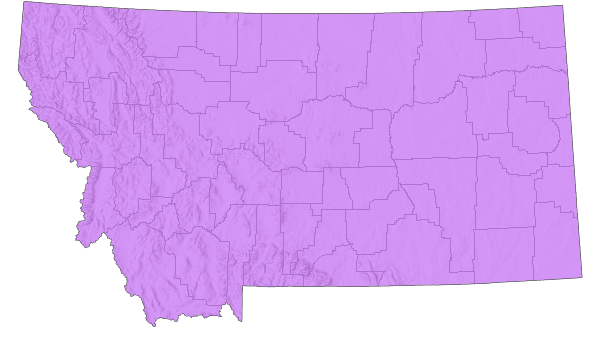
 Non-native
Non-native
Range Comments
Scattered across much of MT; throughout North America (Lesica et al. 2012. Manual of Montana Vascular Plants. BRIT Press. Fort Worth, TX).
Observations in Montana Natural Heritage Program Database
Number of Observations: 46
(Click on the following maps and charts to see full sized version)
Map Help and Descriptions
Relative Density
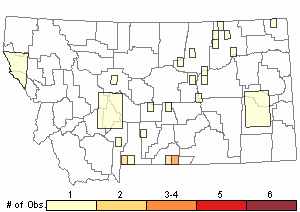
Recency
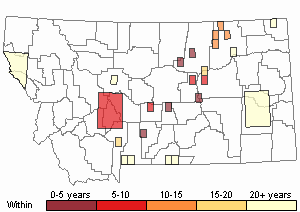

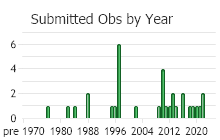
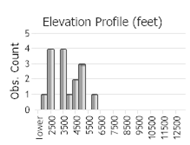 (Observations spanning multiple months or years are excluded from time charts)
(Observations spanning multiple months or years are excluded from time charts)
Habitat
Cultivated fields, disturbed pastures, roadsides, streambanks; plains, valleys (
Lesica et al. 2012. Manual of Montana Vascular Plants. BRIT Press. Fort Worth, TX).
Stewardship Responsibility
References
- Literature Cited AboveLegend:
 View Online Publication
View Online Publication Lesica, P., M.T. Lavin, and P.F. Stickney. 2012. Manual of Montana Vascular Plants. Fort Worth, TX: BRIT Press. viii + 771 p.
Lesica, P., M.T. Lavin, and P.F. Stickney. 2012. Manual of Montana Vascular Plants. Fort Worth, TX: BRIT Press. viii + 771 p.
- Additional ReferencesLegend:
 View Online Publication
View Online Publication
Do you know of a citation we're missing? Clark, D. 1991. The effect of fire on Yellowstone ecosystem seed banks. M.Sc. Thesis. Montana State University, Bozeman. 115 pp.
Clark, D. 1991. The effect of fire on Yellowstone ecosystem seed banks. M.Sc. Thesis. Montana State University, Bozeman. 115 pp. Eggers, M.J.S. 2005. Riparian vegetation of the Montana Yellowstone and cattle grazing impacts thereon. M.Sc. Thesis. Montana State University, Bozeman, MT. 125 p.
Eggers, M.J.S. 2005. Riparian vegetation of the Montana Yellowstone and cattle grazing impacts thereon. M.Sc. Thesis. Montana State University, Bozeman, MT. 125 p. Jones, W. W. 1901. Preliminary flora of Gallatin County. M.S. Thesis. Bozeman, MT: Montana State College. 78 pp.
Jones, W. W. 1901. Preliminary flora of Gallatin County. M.S. Thesis. Bozeman, MT: Montana State College. 78 pp. Lesica, P., M.T. Lavin, and P.F. Stickney. 2022. Manual of Montana Vascular Plants, Second Edition. Fort Worth, TX: BRIT Press. viii + 779 p.
Lesica, P., M.T. Lavin, and P.F. Stickney. 2022. Manual of Montana Vascular Plants, Second Edition. Fort Worth, TX: BRIT Press. viii + 779 p. Seipel, T.F. 2006. Plant species diversity in the sagebrush steppe of Montana. M.Sc. Thesis. Bozeman, MT: Montana State University. 87 p.
Seipel, T.F. 2006. Plant species diversity in the sagebrush steppe of Montana. M.Sc. Thesis. Bozeman, MT: Montana State University. 87 p. Sirirugsa, P. 1973. Descriptive analysis of Montana species of Amaranthus. M.Sc. Thesis. Bozeman, MT: Montana State University. 56 p.
Sirirugsa, P. 1973. Descriptive analysis of Montana species of Amaranthus. M.Sc. Thesis. Bozeman, MT: Montana State University. 56 p.
- Web Search Engines for Articles on "White Amaranth"





